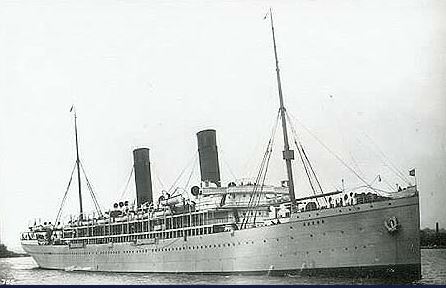Difference between revisions of "SS Saxon"
From Our Contribution
(→England to Tasmania 11 December 1918 - 31 January 1919) |
|||
| Line 6: | Line 6: | ||
| subheader = | | subheader = | ||
| − | | image = [[File:SS_Saxon.jpg|border| | + | | image = [[File:SS_Saxon.jpg|border|]] |
| caption = | | caption = | ||
| image2 = | | image2 = | ||
| Line 21: | Line 21: | ||
| label3 = Builder/Built | | label3 = Builder/Built | ||
| − | | data3 = 1900 | + | | data3 = 1900 Harland & Wolff, Belfast |
| label4 = Type | | label4 = Type | ||
| Line 40: | Line 40: | ||
Originally ordered by the Union Steam Shipping Co, she was sold while being fitted out to the Union-Castle Mail Steam Shipping Co. Used on the UK-South Africa route. | Originally ordered by the Union Steam Shipping Co, she was sold while being fitted out to the Union-Castle Mail Steam Shipping Co. Used on the UK-South Africa route. | ||
| − | + | ||
| + | During World War I Saxon remained on commercial service, although her third-class was devoted to troop-carrying on occasion. (Since Southampton had become a military port when the war began, Saxon's British terminus was moved to London.) From 1917 on, she was used full-time for trooping, primarily in the Mediterranean, and after the Armistice she repatriated Australian troops before being refitted for passenger service again. | ||
| + | |||
| + | Saxon resumed her Union-Castle service in 1919, and remained on the mail service through 1930. She made her final sailing on the intermediate service in January 1931 and was then laid up as a "reserve" ship. She was scrapped at Blyth in 1935, the last survivor of the Union Line flee | ||
==Soldiers carried== | ==Soldiers carried== | ||
Revision as of 02:07, 10 April 2019
 | |
| History | |
|---|---|
| Name | SS Saxon |
| Builder/Built | 1900 Harland & Wolff, Belfast |
| Type | Passenger / cargo ship |
| Displacement | 12,385 tons |
| Speed | knots |
Contents
Remarks
Originally ordered by the Union Steam Shipping Co, she was sold while being fitted out to the Union-Castle Mail Steam Shipping Co. Used on the UK-South Africa route.
During World War I Saxon remained on commercial service, although her third-class was devoted to troop-carrying on occasion. (Since Southampton had become a military port when the war began, Saxon's British terminus was moved to London.) From 1917 on, she was used full-time for trooping, primarily in the Mediterranean, and after the Armistice she repatriated Australian troops before being refitted for passenger service again.
Saxon resumed her Union-Castle service in 1919, and remained on the mail service through 1930. She made her final sailing on the intermediate service in January 1931 and was then laid up as a "reserve" ship. She was scrapped at Blyth in 1935, the last survivor of the Union Line flee